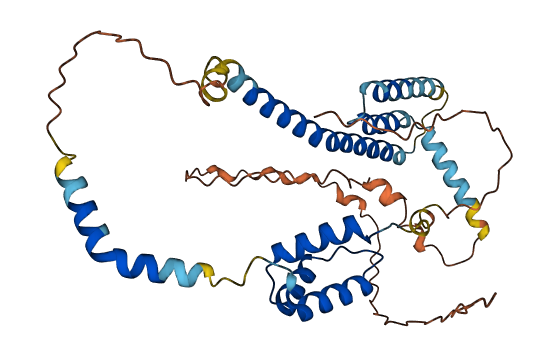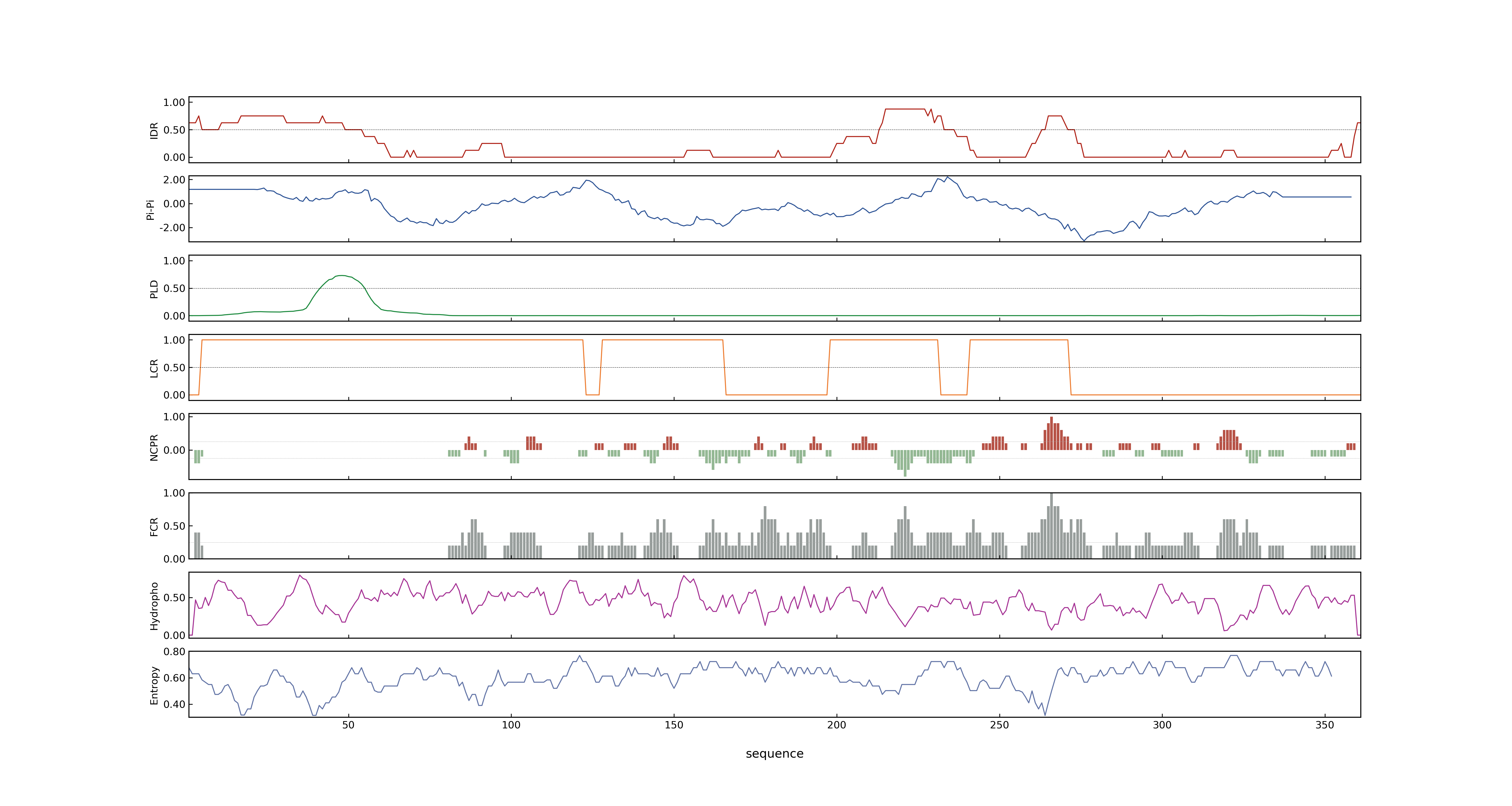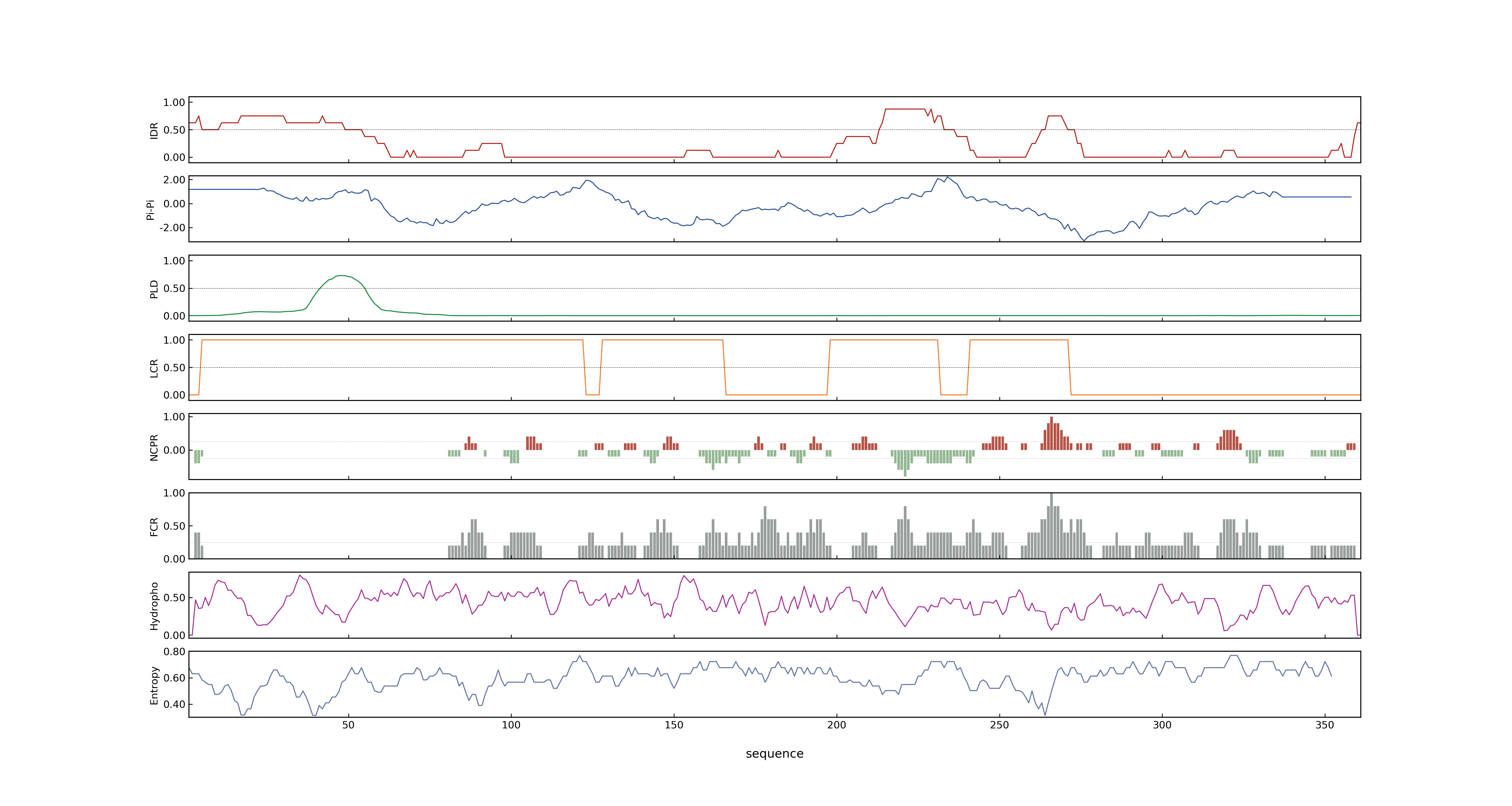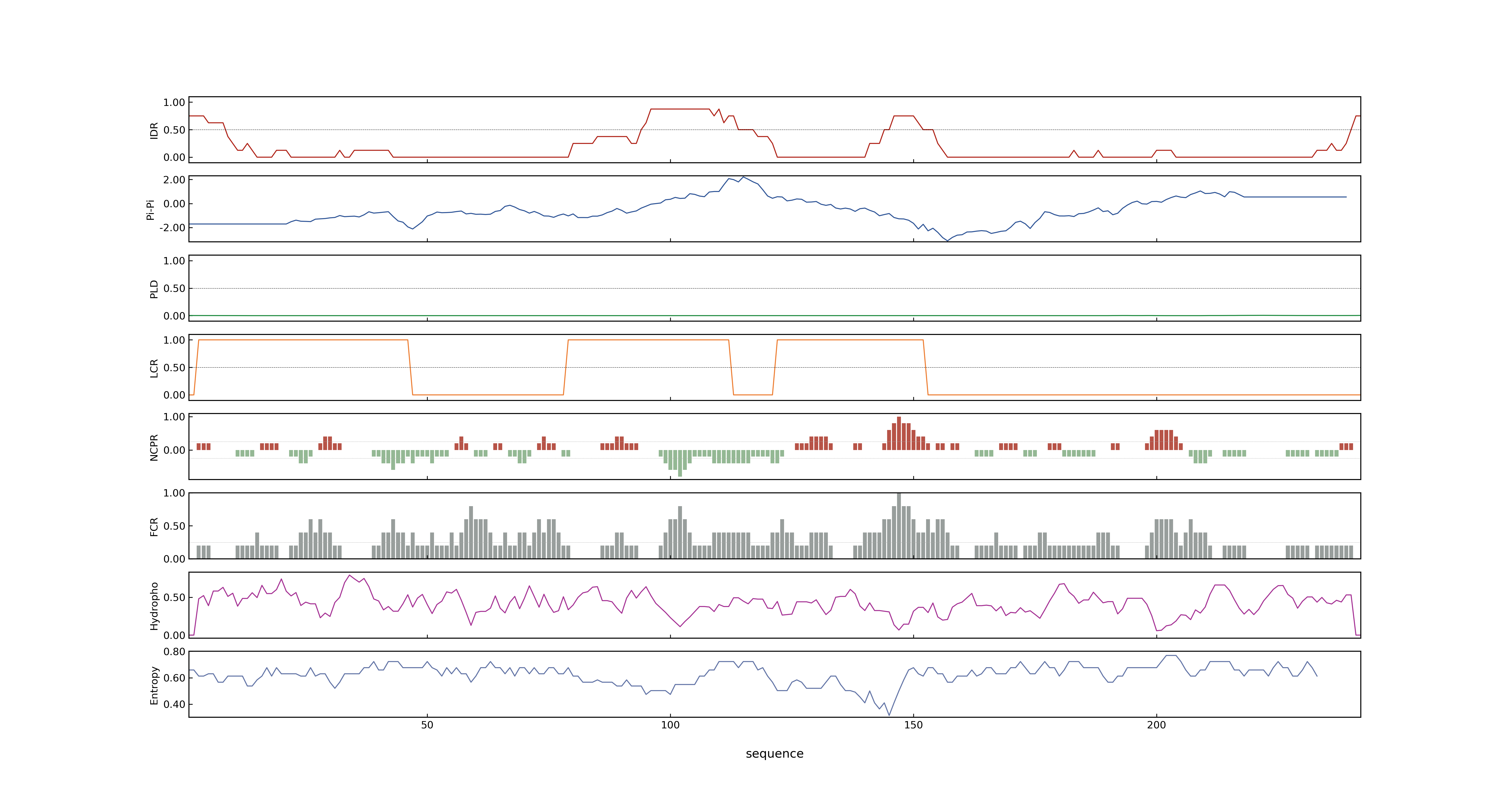- Information
- Symbol: OSH1,Oskn1
- MSU: LOC_Os03g51690
- RAPdb: Os03g0727000
- PSP score
- LOC_Os03g51690.3: 0.0683
- LOC_Os03g51690.1: 0.759
- LOC_Os03g51690.2: 0.759
- PLAAC score
- LOC_Os03g51690.3: 0
- LOC_Os03g51690.1: 0
- LOC_Os03g51690.2: 0
- pLDDT score
- 65.69
- Protein Structure from AlphaFold and UniProt
- MolPhase score
- LOC_Os03g51690.1: 0.98106706
- LOC_Os03g51690.2: 0.98106706
- LOC_Os03g51690.3: 0.92089283
- MolPhase Result
- Publication
- Two transcripts with different sizes derived from a rice homeobox gene, OSH1, 1996, Biochem Biophys Res Commun.
- Overexpression of rice OSH genes induces ectopic shoots on leaf sheaths of transgenic rice plants, 2000, Dev Biol.
- Disruption of KNOX gene suppression in leaf by introducing its cDNA in rice, 2008, Plant Science.
- Isolation and characterization of a rice homebox gene, OSH15, 1998, Plant Mol Biol.
- Characterization of the KNOX class homeobox genes Oskn2 and Oskn3 identified in a collection of cDNA libraries covering the early stages of rice embryogenesis, 1999, Plant Mol Biol.
- KNOX homeobox genes are sufficient in maintaining cultured cells in an undifferentiated state in rice, 2001, Genesis.
- Regional expression of the rice KN1-type homeobox gene family during embryo, shoot, and flower development, 1999, Plant Cell.
- Decreased GA1 Content Caused by the Overexpression of OSH1 Is Accompanied by Suppression of GA 20-Oxidase Gene Expression, 1998, Plant Physiol.
- Positive autoregulation of a KNOX gene is essential for shoot apical meristem maintenance in rice, 2011, Plant Cell.
- The gene FLORAL ORGAN NUMBER1 regulates floral meristem size in rice and encodes a leucine-rich repeat receptor kinase orthologous to Arabidopsis CLAVATA1, 2004, Development.
- A rice tryptophan deficient dwarf mutant, tdd1, contains a reduced level of indole acetic acid and develops abnormal flowers and organless embryos, 2009, Plant J.
- Shoot organization genes regulate shoot apical meristem organization and the pattern of leaf primordium initiation in rice, 2000, Plant Cell.
- Expression of a rice homeobox gene causes altered morphology of transgenic plants, 1993, Plant Cell.
- A rice homeobox gene, OSH1, is expressed before organ differentiation in a specific region during early embryogenesis, 1996, Proc Natl Acad Sci U S A.
- Genome-Wide Study of KNOX Regulatory Network Reveals Brassinosteroid Catabolic Genes Important for Shoot Meristem Function in Rice, 2014, The Plant Cell.
- Genbank accession number
- Key message
- Introduction of the cloned OSH1 gene into rice resulted in altered leaf morphology, which was similar to that of the maize morphological mutant Knotted-1 (Kn1), indicating that OSH1 is a rice gene homologous to the maize Kn1 gene
- Whereas the expression of OSH1 continued within the shoot apical meristem, OSH15 expression within the shoot apical meristem ceased but became observable in a ring shaped pattern at the boundaries of some embryonic organs
- RNA in situ localization data suggest that OSH15 may play roles in the shoot organization during early embryogenesis and thereafter, OSH15 may be involved in morphogenetic events around the shoot apical meristem
- We produced transgenic rice calli, which constitutively express each of four KNOX family class 1 homeobox genes of rice, OSH1, OSH16, OSH15, and OSH71, and found that constitutive and ectopic expression of such genes inhibits normal regeneration from transformed calli, which showed continuous growth around their shoot-regenerating stages
- Rapid and random leaf production in sho mutants is correlated with the frequent and disorganized cell divisions in the shoot meristem and with a reduction of expression domain of a rice homeobox gene, OSH1
- Interestingly, loss-of-function mutants of OSH1 lose the SAM just after germination but can be rescued to grow until reproductive development when they are regenerated from callus
- Here we report the results of our analysis on the regulatory mechanism(s) ofOSH1 on GA metabolism
- The internal GA1 and GA20 contents inOSH1-transformed tobacco were dramatically reduced compared with those of wild-type plants, whereas the level of GA19, a mid-product of GA 20-oxidase, was 25% of the wild-type level
- RNA-blot analysis revealed that GA 20-oxidase gene expression was suppressed in stem tissue of OSH1-transformed tobacco plants
- Based on these results, we conclude that overexpression ofOSH1 causes a reduction of the level of GA1by suppressing GA 20-oxidase expression
- Decreased GA1 Content Caused by the Overexpression of OSH1 Is Accompanied by Suppression of GA 20-Oxidase Gene Expression
- In the normal shoot-regeneration process of calli, expression of endogenous OSH1 was restricted in presumptive shoot-regenerating regions of calli and not observed in other areas
- A 5’ upstream region of OSH1 had the ability to direct the expression of a reporter gene in leaf in addition to the SAM
- Introduction of OSH1 cDNA without a promoter sequence caused ectopic expression of both endogenous OSH1 and introduced OSH1 cDNA itself into the leaf, which resulted in morphological abnormalities in the leaf resembling those of the overexpressors
- These results indicate that an extra copy of OSH1 exons with no promoter sequence disrupts suppression of OSH1 in the transgenic leaf
- Consistent with this result, OSH1, a molecular marker of meristematic indeterminate cells in rice, continues to be expressed in this region
- In tdd1 embryos, the expression patterns of OSH1 and OsSCR, which mark the presumptive apical region and the L2 layer, respectively, are identical to those in WT, suggesting a possibility either that different IAA levels are required for basic pattern formation than for organ formation or that an orthologous gene compensates for TDD1 deficiency during pattern formation
- In situ hybridization analysis revealed that in the wild-type embryo, OSH1 was first expressed at the globular stage, much earlier than organogenesis started, in a ventral region where shoot apical meristem and epiblast would later develop
- At later stages after organogenesis had initiated, OSH1 expression was observed in shoot apical meristem [except in the L1 (tunica) layer], epiblast, radicle, and their intervening tissues in descending strength of expression level with embryonic maturation
- We report that a rice (Oryza sativa) KNOX gene Oryza sativa homeobox1 (OSH1) represses the brassinosteroid (BR) phytohormone pathway through activation of BR catabolism genes.
- Connection
- D6~OSH15~Oskn3, OSH1~Oskn1, Isolation and characterization of a rice homebox gene, OSH15, We analyzed the in situ mRNA localization of OSH15 through the whole plant life cycle, comparing the expression pattern with that of another rice homeobox gene, OSH1
- D6~OSH15~Oskn3, OSH1~Oskn1, Isolation and characterization of a rice homebox gene, OSH15, Whereas the expression of OSH1 continued within the shoot apical meristem, OSH15 expression within the shoot apical meristem ceased but became observable in a ring shaped pattern at the boundaries of some embryonic organs
- OSH1~Oskn1, OSH71~Oskn2, Characterization of the KNOX class homeobox genes Oskn2 and Oskn3 identified in a collection of cDNA libraries covering the early stages of rice embryogenesis, Two of these, Oskn2 and Oskn3, encode newly described KNOX genes, whereas the third (Oskn1) corresponds to the previously described OSH1 gene
- OSH1~Oskn1, OSH71~Oskn2, Characterization of the KNOX class homeobox genes Oskn2 and Oskn3 identified in a collection of cDNA libraries covering the early stages of rice embryogenesis, Transgenic expression of Oskn2 and Oskn3 in tobacco further supported their involvement in cell fate determination, like previously reported for Knotted1 and OSH1 ectopic expression
- D6~OSH15~Oskn3, OSH1~Oskn1, Characterization of the KNOX class homeobox genes Oskn2 and Oskn3 identified in a collection of cDNA libraries covering the early stages of rice embryogenesis, Two of these, Oskn2 and Oskn3, encode newly described KNOX genes, whereas the third (Oskn1) corresponds to the previously described OSH1 gene
- D6~OSH15~Oskn3, OSH1~Oskn1, Characterization of the KNOX class homeobox genes Oskn2 and Oskn3 identified in a collection of cDNA libraries covering the early stages of rice embryogenesis, Whereas OSH1 was previously proposed to function also in SAM maintenance, Oskn3 may be involved in patterning organ positions, as its expression was found to mark the boundaries of different embryonic organs following SAM formation
- D6~OSH15~Oskn3, OSH1~Oskn1, Characterization of the KNOX class homeobox genes Oskn2 and Oskn3 identified in a collection of cDNA libraries covering the early stages of rice embryogenesis, Transgenic expression of Oskn2 and Oskn3 in tobacco further supported their involvement in cell fate determination, like previously reported for Knotted1 and OSH1 ectopic expression
- D6~OSH15~Oskn3, OSH1~Oskn1, KNOX homeobox genes are sufficient in maintaining cultured cells in an undifferentiated state in rice, We produced transgenic rice calli, which constitutively express each of four KNOX family class 1 homeobox genes of rice, OSH1, OSH16, OSH15, and OSH71, and found that constitutive and ectopic expression of such genes inhibits normal regeneration from transformed calli, which showed continuous growth around their shoot-regenerating stages
- OSH1~Oskn1, OSH71~Oskn2, KNOX homeobox genes are sufficient in maintaining cultured cells in an undifferentiated state in rice, We produced transgenic rice calli, which constitutively express each of four KNOX family class 1 homeobox genes of rice, OSH1, OSH16, OSH15, and OSH71, and found that constitutive and ectopic expression of such genes inhibits normal regeneration from transformed calli, which showed continuous growth around their shoot-regenerating stages
- D6~OSH15~Oskn3, OSH1~Oskn1, Positive autoregulation of a KNOX gene is essential for shoot apical meristem maintenance in rice, Double mutants of osh1 and d6, a loss-of-function mutant of OSH15, fail to establish the SAM both in embryogenesis and regeneration
- D6~OSH15~Oskn3, OSH1~Oskn1, Positive autoregulation of a KNOX gene is essential for shoot apical meristem maintenance in rice, We demonstrate that OSH1 directly binds to five KNOX loci, including OSH1 and OSH15, through evolutionarily conserved cis-elements and that the positive autoregulation of OSH1 is indispensable for its own expression and SAM maintenance
- OSH1~Oskn1, TDD1~OASB1, A rice tryptophan deficient dwarf mutant, tdd1, contains a reduced level of indole acetic acid and develops abnormal flowers and organless embryos, In tdd1 embryos, the expression patterns of OSH1 and OsSCR, which mark the presumptive apical region and the L2 layer, respectively, are identical to those in WT, suggesting a possibility either that different IAA levels are required for basic pattern formation than for organ formation or that an orthologous gene compensates for TDD1 deficiency during pattern formation
- OSH1~Oskn1, OsSCR, A rice tryptophan deficient dwarf mutant, tdd1, contains a reduced level of indole acetic acid and develops abnormal flowers and organless embryos, In tdd1 embryos, the expression patterns of OSH1 and OsSCR, which mark the presumptive apical region and the L2 layer, respectively, are identical to those in WT, suggesting a possibility either that different IAA levels are required for basic pattern formation than for organ formation or that an orthologous gene compensates for TDD1 deficiency during pattern formation
- CYP734A6, OSH1~Oskn1, Genome-Wide Study of KNOX Regulatory Network Reveals Brassinosteroid Catabolic Genes Important for Shoot Meristem Function in Rice, Among these targets, BR catabolism genes CYP734A2, CYP734A4, and CYP734A6 were rapidly upregulated by OSH1 induction.
- CYP734A2, OSH1~Oskn1, Genome-Wide Study of KNOX Regulatory Network Reveals Brassinosteroid Catabolic Genes Important for Shoot Meristem Function in Rice, Among these targets, BR catabolism genes CYP734A2, CYP734A4, and CYP734A6 were rapidly upregulated by OSH1 induction.
- CYP734A4, OSH1~Oskn1, Genome-Wide Study of KNOX Regulatory Network Reveals Brassinosteroid Catabolic Genes Important for Shoot Meristem Function in Rice, Among these targets, BR catabolism genes CYP734A2, CYP734A4, and CYP734A6 were rapidly upregulated by OSH1 induction.
- OSH1~Oskn1, OSHB1~LF1, LATERAL FLORET 1 induced the three-florets spikelet in rice., Ectopic expression of both LF1 and the meristem maintenance gene OSH1 was detected in the axil of the sterile lemma primordia of the lf1 spikelet
- OSH1~Oskn1, OSHB1~LF1, LATERAL FLORET 1 induced the three-florets spikelet in rice., Furthermore, the promoter of OSH1 could be bound directly by LF1 protein
- OSH1~Oskn1, OSHB1~LF1, LATERAL FLORET 1 induced the three-florets spikelet in rice., Collectively, these results indicate that the mutation of LF1 induces ectopic expression of OSH1, which results in the initiation of lateral meristems to generate lateral florets in the axil of the sterile lemma
Prev Next



